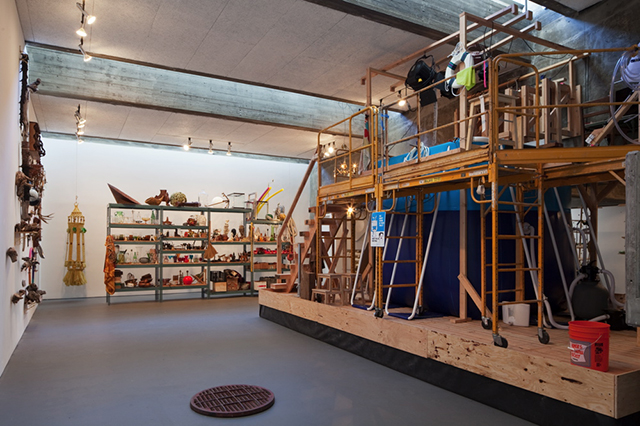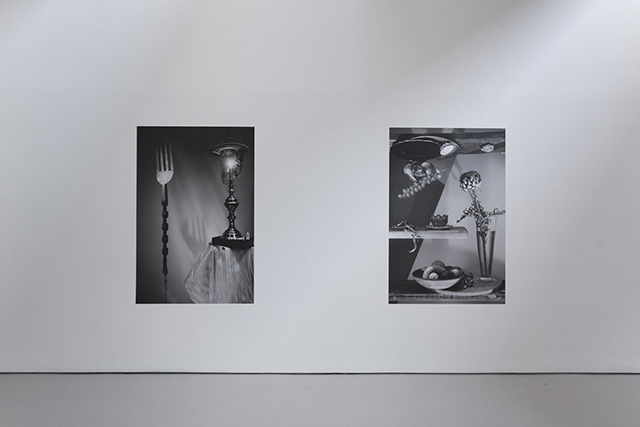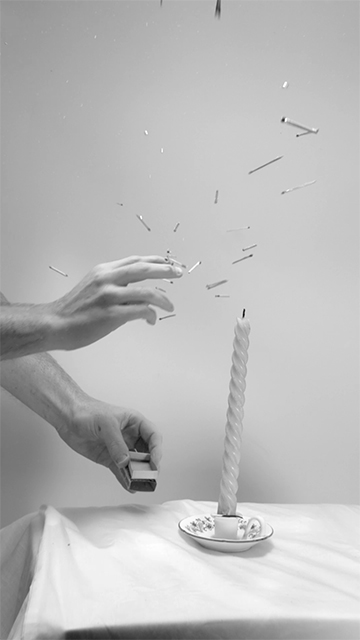For four harrowing months this summer, the sculpture studio at San Francisco Art Institute’s (SFAI) North Beach campus operated under the threat of flooding from above. The source — which thankfully, never leaked — was a 3,000 gallon tank of water in the center of the Walter and McBean Galleries one floor up.
With the help of student workers, protective Plexiglas boxes and countless items of bric-a-brac sourced from thrift stores across the Bay Area, Mexico City-based artist in residence Alejandro Almanza Pereda staged a series of object-filled underwater scenes captured by black and white digital prints and a 20-minute film. The artistic output of his residency is now on view in the same space where all the work was made, in an exhibition titled Everything but the kitchen sank.

Outside the exhibition and just a few doors down the hall is Pereda’s radical intervention in the Diego Rivera Gallery. Change the world or go home uses fluorescent tubes to erect a scaffolding of pure white light in front of the 1931 Rivera fresco The Making of a Fresco Showing the Building of a City.
The fresco itself depicts the wooden armature of the scaffolding Rivera and his assistants used to complete the project. Pereda’s ghostly reminder of invisible labor is part of an ongoing series, but in the Bay Area it takes on added significance. The scaffold becomes not just a symbol of construction, but also one of gentrification, hammered home for me by the “Dreamboat,” dominating the view from SFAI’s rooftop. That was, if you don’t remember, the gigantic cruise ship rented by Salesforce to host attendees of the tech giant’s annual Dreamforce conference because San Francisco didn’t have enough hotel rooms to accommodate the crowd.

Back in the Walter and McBean Galleries, the installation is spare and soothingly monochromatic. Pereda’s large-scale prints of different gravity-defying still life arrangements sit flush on the gallery walls like pieces of vinyl. Photographed through Plexiglas and water, the images take on a somber and surreal brushy quality as dish ware, fruits, vegetables and concrete blocks combine in tableaux punctuated by Pereda’s groan-worthy punny titles. (The photograph Just five blocks away contains an arrangement with — you guessed it — five concrete blocks.)

Upstairs in a darkened video room, the black and white film Like Steaks and Salads is the true highlight of the show. A vertical projection captures different experiments with buoyancy and humor, all to the soundtrack of wonderfully clanking piano notes. Does a potato float? No. Does a pencil float? Yes. Pencil shavings hover in stasis, exploding out from the moment of sharpening. If Charlie Chaplin or Buster Keaton were making movies in a 3,000 gallon tank of water with the help of a small army of art school students, they might produce something like this.
While the finished exhibition is a tightly restrained view of the months of watery activity that took place inside that same space, it is in Like Steaks and Salads that the spirit of collaboration and play comes to life as a fitting document of Pereda’s time spent at SFAI. And in the Diego Rivera Gallery, he proves that play can also shift to critique, skillfully inserting himself into Rivera’s legacy at SFAI. Sometimes it takes an outsider’s eyes to call attention to a repeating cycle of history — in this case, both Rivera and Pereda point to San Francisco as a city constantly rebuilding itself, on the backs of a unidentified laborers.